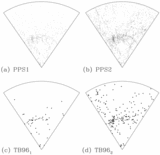Clustering of Loose Groups and Galaxies in the Perseus-Pisces Survey
Abstract
We investigate the clustering properties of loose groups in the Perseus-Pisces redshift survey. Previous analyses based on CfA and SSRS surveys led to apparently contradictory results. We investigate the source of such discrepancies, finding satisfactory explanations for them. Furthermore, we find a definite signal of group clustering, whose amplitude AG exceeds the amplitude Ag of galaxy clustering (AG = 14.5+3.8-3.0, Ag=7.42+0.20-0.19 for the most significant case; distances are measured in h-1 Mpc). Groups are identified with the adaptive friends-of-friends (FOF) algorithms HG (Huchra & Geller) and NW (Nolthenius & White). We debate the dependence of clustering parameters on group individuation recipes, systematically varying all search parameters. Correlation strength is especially sensitive to the sky link DL (increasing for stricter normalization D0) and to the (depth mlim of the) galaxy data. It is only moderately dependent on the galaxy luminosity function φ(L), while it is almost insensitive to the redshift link VL (both to the normalization V0 and to the scaling recipes HG or NW).
- Publication:
-
The Astrophysical Journal
- Pub Date:
- January 1997
- DOI:
- 10.1086/303523
- arXiv:
- arXiv:astro-ph/9606116
- Bibcode:
- 1997ApJ...475....1T
- Keywords:
-
- Galaxies: Clusters: General;
- Cosmology: Large-Scale Structure of Universe;
- Surveys;
- Astrophysics
- E-Print:
- 28 pages (LaTeX aasms4 style) + 5 Postscript figures
